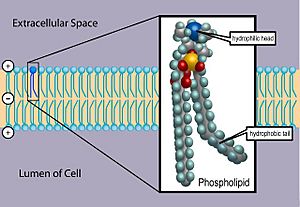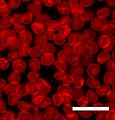Lipid bilayer facts for kids
Imagine a tiny, flexible wall that surrounds every living cell in your body! That's pretty much what a lipid bilayer is. It's a super important part of cells because it forms the cell membrane, which is like the cell's skin. It also wraps around most tiny parts inside a cell, called organelles.
These amazing walls are made from special building blocks called phospholipids. Phospholipids are cool because they have two different ends: a "head" that loves water and a "tail" that hates water. Because of this, they naturally arrange themselves into a double layer, almost like magic! The water-hating tails hide in the middle, away from water, while the water-loving heads face outwards, surrounded by water.
This clever design means that lipid bilayers are great at keeping things separate. They stop most things that dissolve easily in water, like tiny charged particles called ions, from just floating in or out of the cell.
Inside cells, special helpers called proteins are placed into this bilayer wall by other helpers called enzymes. These proteins are like tiny gatekeepers. They decide exactly which molecules can enter or leave the cell. For example, cells use these protein gatekeepers, sometimes called ion pumps, to control how much salt is inside or to keep the cell's acidity (pH) just right.
Contents
What Are Lipid Bilayers?
A lipid bilayer is a very thin, flexible barrier made of two layers of fat-like molecules. These molecules are mostly phospholipids. This double layer is the main part of all cell membranes. It acts like a protective fence around cells and their internal parts.
How They Form Naturally
Phospholipids have a unique structure. Each phospholipid molecule has a "head" part that is attracted to water (hydrophilic). It also has two "tails" that are repelled by water (hydrophobic). When phospholipids are in water, they automatically arrange themselves. They form a double layer where the water-hating tails face each other in the middle. The water-loving heads face outwards, touching the water on both sides. This process is called self-assembly.
Why Are Lipid Bilayers Important?
Lipid bilayers are vital for life because they create compartments. They allow cells to keep their inside environment different from their outside environment. This separation is key for all life processes.
Controlling What Enters and Exits
The main job of a lipid bilayer is to control what goes in and out of a cell. Because the middle of the bilayer is water-hating, it's hard for water-soluble molecules to pass through. This means the cell can decide what it needs and what it doesn't.
The Role of Proteins
While the lipid bilayer forms the basic wall, proteins are the ones that do most of the work. These proteins are inserted into or across the bilayer. They act as:
- Channels: Like tunnels that allow specific molecules to pass through.
- Pumps: Actively move molecules from one side to the other, even against a concentration difference.
- Receptors: Receive signals from outside the cell and pass them inside.
For example, cells use special protein pumps to move ions like sodium or potassium. This helps them maintain the right balance of salts and control their internal acidity. Without these proteins, the cell couldn't function properly.
Images for kids
-
This fluid lipid bilayer cross section is made up entirely of phosphatidylcholine.
-
Transmission Electron Microscope (TEM) image of a lipid vesicle. The two dark bands around the edge are the two leaflets of the bilayer. Historically, similar images confirmed that the cell membrane is a bilayer
-
Human red blood cells viewed through a fluorescence microscope. The cell membrane has been stained with a fluorescent dye. Scale bar is 20μm.
-
3d-Adapted AFM images showing formation of transmembrane pores (holes) in supported lipid bilayer
-
Illustration of a typical AFM scan of a supported lipid bilayer. The pits are defects in the bilayer, exposing the smooth surface of the substrate underneath.
-
Structure of a potassium ion channel. The alpha helices penetrate the bilayer (boundaries indicated by red and blue lines), opening a hole through which potassium ions can flow
See also
 In Spanish: Bicapa lipídica para niños
In Spanish: Bicapa lipídica para niños











